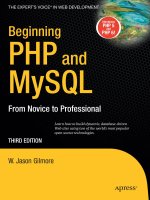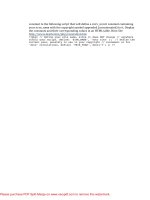Chapter 5 php and mysql
Bạn đang xem bản rút gọn của tài liệu. Xem và tải ngay bản đầy đủ của tài liệu tại đây (687.18 KB, 60 trang )
Chapter 5
PHP and MySQL
Lectured by:
Nguyễn Hữu Hiếu
Objectives
In this lesson, you will:
• Connect to MySQL from PHP
• Work with MySQL databases using PHP
• Create, modify, and delete MySQL tables with
PHP
• Use PHP to manipulate MySQL records
• Use PHP to retrieve database records
Trường Đại Học Bách Khoa TP.HCM
Khoa Khoa Học và Kỹ Thuật Máy Tính
© 2020
Lập Trình
2 Web
2
Connecting to MySQL with PHP
• PHP has the ability to access and manipulate
any database that is ODBC (Open Database
Connectivity) compliant
• PHP includes functionality that allows you to
work directly with different types of databases,
without going through ODBC
Trường Đại Học Bách Khoa TP.HCM
Khoa Khoa Học và Kỹ Thuật Máy Tính
© 2020
Lập Trình
3 Web
3
Which MySQL Package to Use
• The mysqli (MySQL Improved) package became
available with PHP 5 and is designed to work with
MySQL version 4.1.3 and later
• Earlier versions must use the mysql package
• The mysqli package is the object-oriented equivalent of
the mysql package but can also be used procedurally
• Mysqli package has improved speed, security and
compatibility with libraries.
Trường Đại Học Bách Khoa TP.HCM
Khoa Khoa Học và Kỹ Thuật Máy Tính
© 2020
Lập Trình
4 Web
4
Opening and Closing a Connection
• Open a connection to a MySQL database server
with the mysqli_connect() function
• The mysqli_connect() function returns a positive
integer if it connects to the database
successfully or FALSE if it does not
• Assign the return value from the
mysqli_connect() function to a variable that you
can use to access the database in your script
Trường Đại Học Bách Khoa TP.HCM
Khoa Khoa Học và Kỹ Thuật Máy Tính
© 2020
Lập Trình
5 Web
5
Opening and Closing a Connection
• The syntax for the mysqli_connect()
function is:
$connection = mysqli_connect("host" [, "user",
"password"[,”database”]]);
• The host argument specifies the host name
where your MySQL database server is installed
• The user and password arguments specify a MySQL
account name and password
• You can optionally select the database when connecting.
Trường Đại Học Bách Khoa TP.HCM
Khoa Khoa Học và Kỹ Thuật Máy Tính
© 2020
Lập Trình
6 Web
6
Opening and Closing a Connection
• The database connection is assigned to the $DBConnect
variable
$DBConnect = mysqli_connect("localhost",
"billyeakus ", "hotdog");
•
Close a database connection using the mysql_close()
function
mysqli_close($DBConnect);
Trường Đại Học Bách Khoa TP.HCM
Khoa Khoa Học và Kỹ Thuật Máy Tính
© 2020
Lập Trình
7 Web
7
Opening and Closing a Connection
mysqli_get_client_info()
mysqli_get_client_stats()
mysqli_get_client_version()
mysqli_get_connection_stats()
mysqli_get_host_info()
mysqli_get_proto_info()
mysqli_get_server_info()
mysqli_get_server_version()
Trường Đại Học Bách Khoa TP.HCM
Khoa Khoa Học và Kỹ Thuật Máy Tính
© 2020
Returns the MySQL client library version
Returns statistics about client per-process
Returns the MySQL client library version as an integer
Returns statistics about the client connection
Returns the MySQL server hostname and the
connection type
Returns the MySQL protocol version
Returns the MySQL server version
Returns the MySQL server version as an integer
Lập Trình
8 Web
8
Opening and Closing a Connection
version.php in a Web browser
Trường Đại Học Bách Khoa TP.HCM
Khoa Khoa Học và Kỹ Thuật Máy Tính
© 2020
Lập Trình
9 Web
9
Reporting MySQL Errors
• Reasons for not connecting to a database
server include:
– The database server is not running
– Insufficient privileges to access the data source
– Invalid username and/or password
Trường Đại Học Bách Khoa TP.HCM
Khoa Khoa Học và Kỹ Thuật Máy Tính
© 2020
Lập Trình
10 Web
10
Reporting MySQL Errors
• The mysqli_errno() function returns the error code from
the last attempted MySQL function call or 0 if no error
occurred
• The mysqli_error() — Returns the text of the error
message from previous MySQL operation
• The mysqli_errno() and mysqli_error() functions return
the results of the previous mysqli*() function
Trường Đại Học Bách Khoa TP.HCM
Khoa Khoa Học và Kỹ Thuật Máy Tính
© 2020
Lập Trình
11 Web
11
Selecting a Database
• The syntax for the mysqli_select_db() function
is:
mysqli_select_db(connection, database);
• The function returns a value of TRUE if it
successfully selects a database or FALSE if it
does not
• For security purposes, you may choose to use
an include file to connect to the MySQL server
and select a database
Trường Đại Học Bách Khoa TP.HCM
Khoa Khoa Học và Kỹ Thuật Máy Tính
© 2020
Lập Trình
12 Web
12
Sample Code
good
$link = mysqli_connect("cs.mvnu.edu",
“demo", “demo");
bad
good
bad
mysqli_select_db($link, "nonexistentdb”);
echo mysql_errno($link) . ": " .
mysql_error($link). "
";
mysqli_select_db( $link, “demo");
mysqli_query($link,
"SELECT * FROM nonexistenttable");
echo mysqli_errno($link) . ": " .
mysqli_error($link) . "
";
Trường Đại Học Bách Khoa TP.HCM
Khoa Khoa Học và Kỹ Thuật Máy Tính
© 2020
Lập Trình
13 Web
13
Sample Code
$host='localhost';
$userName = 'demo';
$password = 'demo';
$database ='demo';
$link = mysqli_connect ($host, $userName, $password) ;
if (!$link) {
die('Could not connect: ' . mysqli_error($link));
}
echo 'Connected successfully';
mysqli_close($link);
Trường Đại Học Bách Khoa TP.HCM
Khoa Khoa Học và Kỹ Thuật Máy Tính
© 2020
Lập Trình
14 Web
14
include(‘file.php’); include_once(‘file.php’)
require(‘file.php’); require_once(‘file.php’);
index.php
include_once(‘config/file.php’);
echo “test”;
include(‘config/file.php’);
?>
config/file.php
include(‘file2.php’);
?>
Trường Đại Học Bách Khoa TP.HCM
Khoa Khoa Học và Kỹ Thuật Máy Tính
© 2020
Lập Trình Web
15
Sample Code
$link = mysqli_connect('localhost', 'mysql_user', 'mys
ql_password');
if (!$link) {
die('Not connected : ' . mysqli_error($link));
}
// make foo the current db
$db_selected = mysqli_select_db($link,'foo');
if (!$db_selected) {
die ('Can\'t use foo : ' . mysqli_error($link));
}
?>
Trường Đại Học Bách Khoa TP.HCM
Khoa Khoa Học và Kỹ Thuật Máy Tính
© 2020
Lập Trình
16 Web
16
Executing SQL Statements
• Use the mysqli_query() function to send SQL
statements to MySQL
• The syntax for the mysqli_query() function is:
mysqli_query(connection, query);
• The mysqli_query() function returns one of three
values:
– For SQL statements that do not return results
(CREATE DATABASE and CREATE TABLE
statements) it returns a value of TRUE if the
statement executes successfully
Trường Đại Học Bách Khoa TP.HCM
Khoa Khoa Học và Kỹ Thuật Máy Tính
© 2020
Lập Trình
17 Web
17
Executing SQL Statements
– For SQL statements that return results (SELECT
and SHOW statements) the mysqli_query()
function returns a result pointer that represents
the query results
•A result pointer is a special type of variable that
refers to the currently selected row in a resultset
– The mysqli_query() function returns a value
of FALSE for any SQL statements that fail,
regardless of whether they return results
Trường Đại Học Bách Khoa TP.HCM
Khoa Khoa Học và Kỹ Thuật Máy Tính
© 2020
Lập Trình
18 Web
18
Sample Code
// This could be supplied by a user, for example
$firstname = 'fred';
$lastname = 'fox';
//never trust user data
$firstname= mysql_real_escape_string($firstname);
$lastname= mysql_real_escape_string($lastname);
// Formulate Query
// For more examples, see mysql_real_escape_string()
$query = "SELECT firstname, lastname, address, age FROM friends WHERE firstname=‘$firstname ‘
AND lastname= ‘$lastname’”;
// Perform Query
$result = mysql_query($query);
// Check result
// This shows the actual query sent to MySQL, and the error. Useful for debugging.
if (!$result) {
$message = 'Invalid query: ' . mysql_error() . "
";
$message .= 'Whole query: ' . $query;
die($message);
}
// Use result
// Attempting to print $result won't allow access to information in the resource
// One of the mysql result functions must be used
// See also mysql_fetch_array(), mysql_fetch_row(), etc.
while ($row = mysql_fetch_assoc($result)) {
echo $row['firstname'];
echo $row['lastname'];
echo $row['address'];
echo $row['age'];
}
// Free the resources associated with the result set
// This is done automatically at the end of the script
mysql_free_result($result);
?>
Trường Đại Học Bách Khoa TP.HCM
Khoa Khoa Học và Kỹ Thuật Máy Tính
© 2020
Lập Trình
19 Web
19
Adding, Deleting, and Updating Records
• To add records to a table, use the INSERT and
VALUES keywords with the mysqli_query()
function
• To add multiple records to a database, use the
LOAD DATA statement with the name of the
local text file containing the records you want to
add
• To update records in a table, use the UPDATE
statement
Trường Đại Học Bách Khoa TP.HCM
Khoa Khoa Học và Kỹ Thuật Máy Tính
© 2020
Lập Trình
20 Web
20









